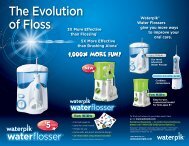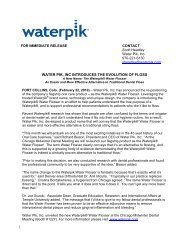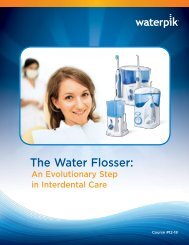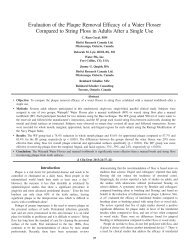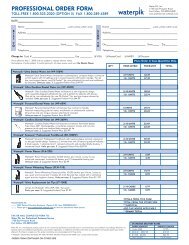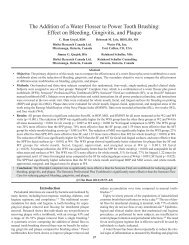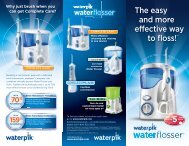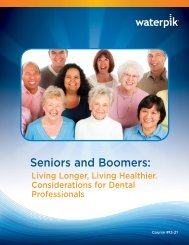The Water Flosser: - Waterpik
The Water Flosser: - Waterpik
The Water Flosser: - Waterpik
Create successful ePaper yourself
Turn your PDF publications into a flip-book with our unique Google optimized e-Paper software.
<strong>The</strong> <strong>Water</strong> <strong>Flosser</strong>:<br />
An Evolutionary Step<br />
in Interdental Care<br />
Course # 10-13
Disclosure Statement:<br />
• <strong>The</strong> content for this self-study course was developed and<br />
written by Carol A. Jahn, RDH, MS; a <strong>Water</strong> Pik, Inc. employee<br />
• <strong>Water</strong> Pik, Inc. designed and produced this self-study course<br />
• <strong>Water</strong> Pik, Inc. manufactures and distributes products<br />
addressed in this course<br />
Course Objective:<br />
To provide the learner with a comprehensive review of the<br />
research, which will enable the healthcare provider to recommend,<br />
educate, and instruct individuals in the use of a <strong>Water</strong> <strong>Flosser</strong>.<br />
Learning Outcomes:<br />
• List the oral health benefits demonstrated by the <strong>Water</strong> <strong>Flosser</strong><br />
• Discuss the effect the <strong>Water</strong> <strong>Flosser</strong> has on plaque biofilm<br />
and inflammation<br />
• Compare the use of the <strong>Water</strong> <strong>Flosser</strong> to string floss<br />
• Distinguish depth of delivery between the Classic Jet Tip<br />
and Pik Pocket Tip<br />
• Evaluate solutions/agents for use in a <strong>Water</strong> <strong>Flosser</strong><br />
• Understand the benefits of a <strong>Water</strong> <strong>Flosser</strong> for individuals<br />
with gingivitis, periodontitis, implants, diabetes, orthodontics<br />
• Instruct individuals in the use of the <strong>Water</strong> <strong>Flosser</strong><br />
• Recommend the <strong>Water</strong> <strong>Flosser</strong> to appropriate individuals<br />
including when to implement the Plaque Seeker Tip, Pik<br />
Pocket Tip, and Orthodontic Tip<br />
INTRODUCTION<br />
In the early 1960’s, a dentist, Dr. Gerald Moyer and his patient,<br />
John Mattingly, an engineer, worked together to develop a device<br />
for patients to irrigate their mouths at home and improve oral<br />
health. It took multiple attempts until they developed the precise<br />
engineering they needed for the device. Dr. Moyer gave one of<br />
these first units to a patient who had been experiencing periodontal<br />
problems. After six months of use, the patient was so<br />
happy with the improvements in his mouth that he invested in the<br />
company and later went on to be its first president.<br />
Nearly 50 years since its inception, dental professionals still<br />
recommend Dr. Moyer’s product. Over time, this pulsating device<br />
has had many names including oral irrigator, dental cleaning<br />
system, dental water jet, and now <strong>Water</strong> <strong>Flosser</strong>. <strong>The</strong> evolution<br />
of the name correlates to research advancements demonstrated<br />
with the product. Oral irrigator was the initial name and remained<br />
popular especially when many believed it was the agent, not the<br />
device that was responsible for the oral health improvements. As<br />
more studies showed positive results with plain water, the name<br />
progressed to ‘dental water jet’. In the last a five years, emerging<br />
evidence demonstrates the device is an easy, effective alternative<br />
to string floss; hence the evolution to ‘<strong>Water</strong> <strong>Flosser</strong>.’<br />
THE EARLY YEARS: 1964-1979<br />
<strong>The</strong> first <strong>Water</strong> <strong>Flosser</strong> was called the Octopus (Figure 1) and<br />
the delivery tip it came with was the Classic Jet Tip (Figure 2). It<br />
was introduced to the dental profession in 1963; a time when the<br />
non specific plaque hypothesis was the widely held view. 1 At the<br />
on-set, the device was hugely popular. Soon, research that evaluated<br />
the product’s mechanisms of action, safety, and efficacy<br />
were underway.<br />
Figure 1:<br />
<strong>The</strong> First <strong>Water</strong>pik ®<br />
<strong>Water</strong> <strong>Flosser</strong>:<br />
<strong>The</strong> Octopus<br />
Some of the first studies evaluated the safety of the product’s<br />
mechanism of action; pulsation and pressure. <strong>The</strong> production of<br />
1,200 pulsations per minute was found to be a key component<br />
in effectiveness. This rate was shown to create a compression/<br />
decompression phase that expelled debris and bacteria from a<br />
pocket; 2 three times better than a continuous stream device. 3 A<br />
medium to high setting (50 psi-90 psi) was demonstrated to be<br />
safe and more effective than a lower setting (Table 1). 2,3,4 During<br />
this time, US Army oral surgeons serving in Vietnam were familiar<br />
with Dr. Moyer’s device and so confident in it that they modified<br />
the device to cleanse facial wounds. Orthopedic surgeons<br />
followed suit using the unit to clean soft tissue and bone. 5,6<br />
Table 1: Percentage of Debris Removal Based on<br />
Pressure Setting 3 .<br />
Setting<br />
Low<br />
Medium<br />
High<br />
Debris removal with<br />
tip perpendicular to<br />
long axis of the tooth<br />
55%<br />
93%<br />
96%<br />
Figure 2:<br />
<strong>The</strong> Classic Jet Tip<br />
Debris removal with<br />
tip parallel to long<br />
axis of the tooth<br />
81%<br />
95%<br />
97%<br />
2
Because the product was new and different from traditional selfcare<br />
products (toothbrushes and string floss) some researchers<br />
were concerned about the potential of the device to cause penetration<br />
of bacteria into a pocket. Two separate studies stained tissue<br />
with ink and evaluated for penetration of carbon particles. In each<br />
study there was some penetration of carbon into the crevicular<br />
epithelium. 7,8 However, each investigator uncovered mitigating<br />
circumstances to question the results. One found that penetration<br />
was not influenced by water pressure, 7 and the other discovered<br />
that non-irrigated areas also had carbon penetration leading to<br />
speculation that the knife blade caused particle penetration during<br />
the biopsy. 8 Further, the investigator cautioned against drawing<br />
definitive conclusions from the study deeming the controversy<br />
more academic than practical. 8 Krajewski also biopsied tissue post<br />
irrigation and found that tissue that had been irrigated twice daily<br />
had less inflammation, better connective tissue organization, and an<br />
increased thickness in the keratin layer compared to those who did<br />
not use a <strong>Water</strong> <strong>Flosser</strong>. 9 Similarly, biopsies of the interdental col<br />
tissue after one month of <strong>Water</strong> <strong>Flosser</strong> use found less inflammation<br />
compared to non users who had an increase in inflammation. 10<br />
Others evaluated the potential for the development of bacteremia.<br />
Studies indicate that the incidence of bacteremia from<br />
a <strong>Water</strong> <strong>Flosser</strong> is similar to that of other self-care devices and<br />
mastication. 11,12,13,14,15 Findings have shown ranges from 7% in people<br />
with gingivitis 12 to 50% in those with periodontitis. 13 For people<br />
with no history of periodontal disease and no evidence of gingivitis,<br />
Berger et al found a 27% rate of bacteremia 14 whereas Tamini<br />
et al found no subjects developed a bacteremia after using<br />
the device. 15<br />
One of the first studies to review the efficacy of the <strong>Water</strong><br />
<strong>Flosser</strong> was conducted in 1969 by Dr. Ralph Lobene. He found<br />
that the <strong>Water</strong> <strong>Flosser</strong> used once daily with water reduced<br />
gingivitis by 52% compared to 32% for brushing. Subjects using<br />
the <strong>Water</strong> <strong>Flosser</strong> also had 50% less calculus accumulation. 16<br />
Likewise, a different study found subjects that used the <strong>Water</strong><br />
<strong>Flosser</strong> had better periodontal health including less plaque and<br />
calculus. 17 Lainson et al studied the long-term effectiveness of<br />
the <strong>Water</strong> <strong>Flosser</strong>. <strong>The</strong>y found that one year after the completion<br />
of a three month study, 66% of patients were still using the<br />
<strong>Water</strong> <strong>Flosser</strong>, and they had a significant reduction in gingivitis<br />
compared to one year prior. <strong>The</strong>re were no reported harmful<br />
effects on hard or soft tissues. 18<br />
<strong>The</strong> first study to look at the ability of the <strong>Water</strong> <strong>Flosser</strong> to reduce<br />
bacteria was conducted on fully banded orthodontic patients. After<br />
63 days of use, toothbrushing and the <strong>Water</strong> <strong>Flosser</strong> were 80%<br />
more effective than toothbrushing and rinsing in reducing the total<br />
aerobic flora and 60% more effective in reducing the lactobacillus<br />
count. Even though the investigators did not measure plaque, based<br />
on the reduction in lactobacilli, they indicated the results pointed to<br />
a reduction in plaque from tooth surfaces and interproximal spaces. 19<br />
Plaque removal was the main focus of a study by Hugoson.<br />
He utilized an ‘experimental gingivitis in man’ methodology to<br />
evaluate the <strong>Water</strong> <strong>Flosser</strong> as the sole means of oral hygiene and<br />
as an adjunct to toothbrushing. In phase one over a two week<br />
period, he compared no oral hygiene to the use of the <strong>Water</strong><br />
<strong>Flosser</strong> only. Both groups had increases in plaque and gingivitis.<br />
However, those using the <strong>Water</strong> <strong>Flosser</strong> only had less plaque and<br />
inflammation especially on proximal surfaces. In the second two<br />
week phase, toothbrushing was added to both groups. In this<br />
instance, it was determined that toothbrushing removed the<br />
majority of the plaque and that any left was ‘resistant’ to removal<br />
with the <strong>Water</strong> <strong>Flosser</strong>. Interestingly, in spite of the findings,<br />
the investigator concluded that the product did not fulfill the<br />
requirements of a ‘satisfactory plaque control device’ since it did<br />
not prevent plaque accumulation or gingivitis when used like a<br />
toothbrush; as the only means of oral hygiene. 20<br />
THE EIGHTIES<br />
While the product was off to a great start in the early years, in<br />
the 1980’s the product’s ability to remove plaque came under<br />
scrutiny; likely influenced by Hugoson’s conclusion. 20 At that time,<br />
belief in the non specific plaque hypothesis was still prevalent and<br />
supported by experimental gingivitis study models like Hugoson<br />
used. 20 <strong>The</strong> premise was that accumulated plaque exceeds the host<br />
defense system. 1 Today, it is well-established that there are multiple<br />
risk factors at play that determine how a patient responds to<br />
plaque and the amount of inflammation and disease that occur. 21<br />
As well, the <strong>Water</strong> <strong>Flosser</strong> is an adjunct to brushing; not a substitute.<br />
<strong>Water</strong> flossing devices were dealt an additional blow from a case<br />
report that appeared in a 1981 publication called Periodontal Case<br />
Reports. In the article, a periodontist wrote a report on a 23 year<br />
old female with multiple episodes of rapid bone loss around two<br />
first molars and a pre-molar and canine. <strong>The</strong> patient reported using<br />
a ‘water-irrigating’ device. <strong>The</strong> doctor assumed that the device was<br />
used improperly and lead to the rapid periodontal destruction. 22<br />
Today, with the ever-growing knowledge and awareness of what<br />
constitutes good scientific evidence, the case report, like the<br />
one in Periodontal Case Reports, 22 lies near the bottom of the<br />
evidence pyramid 23 (Figure 3). Case reports are considered weak<br />
evidence because there is no verification of the outcome via a<br />
Figure 3: Levels of Evidence Pyramid<br />
Systematic Review<br />
Randomized Clinical Trial<br />
Cohort Studies, Case-control Studies<br />
Case Series/Report, Editorials, Expert opinions<br />
3
control group. 21 For example, today, with greater knowledge of<br />
the different types of periodontal diseases, a 23 year old woman<br />
presenting with two seven millimeter pockets around first<br />
molars would likely have dental professionals culturing bacteria<br />
for the type that cause rapidly progressive aggressive periodontal<br />
disease. 24<br />
At the top of the evidence pyramid is the systematic review and<br />
randomized clinical trial (RCT). <strong>The</strong> RCT is ideal for testing products<br />
and new therapies because they build in safeguards such<br />
as masking and randomization to prevent investigator and/or<br />
confirmation bias. 23 Today, the RCT is still the gold standard in<br />
clinical research.<br />
During the 1980’s, as the emphasis began to shift from the non<br />
specific plaque hypothesis to the specific plaque hypothesis,<br />
several studies examined the effect of the <strong>Water</strong> <strong>Flosser</strong> on<br />
subgingival bacteria. 25,26,27 Importantly, results of these studies<br />
provide evidence to refute the case study’s assumption 22 that<br />
a <strong>Water</strong> <strong>Flosser</strong> drives bacteria into the pocket. 24,25,26 Cobb et al<br />
examined a study population of 12 individuals requiring multiple<br />
extractions due to advanced chronic periodontal disease. Thirtytwo<br />
teeth each with pocket depths of six millimeters and no<br />
prior instrumentation for at least six months were evaluated. Half<br />
the teeth were treated with the <strong>Water</strong> <strong>Flosser</strong> at 60 psi for eight<br />
seconds using only water prior to the extraction. <strong>The</strong> specimens<br />
were treated and examined for bacteria levels by scanning electron<br />
microscopy (SEM) and by transmission electron microscopy<br />
(TEM) for evidence of epithelial cavitation or ulceration. <strong>The</strong><br />
investigators found that the <strong>Water</strong> <strong>Flosser</strong> reduced the number<br />
of microorganisms up to six millimeters. In comparison, the<br />
untreated areas had thick mattes of microbes. <strong>The</strong>re were no<br />
observable differences between the control and test specimens<br />
in regard to the pocket soft tissue wall nor was there evidence<br />
of bacterial penetration. <strong>The</strong>y concluded the pulsating <strong>Water</strong><br />
<strong>Flosser</strong> effected a qualitative change on subgingival plaque and<br />
is not injurious to soft tissue. 25 Similarly, plaque samples taken<br />
from teeth treated with an eight second irrigation with water at<br />
70 psi showed reductions of spirochetes at 3 mm and 6 mm. 26<br />
An antiseptic agent has also demonstrated reductions in microbial<br />
counts. 27<br />
Table 2: Depth of Delivery of Self-Care Devices.<br />
Product Penetration Comments<br />
<strong>Water</strong><br />
<strong>Flosser</strong><br />
Toothpicks/<br />
Wood Points<br />
Interdental<br />
Brushes<br />
6 mm 25,26,28,42 Clinically proven to remove supra<br />
and subgingival plaque biofilm<br />
and bacteria 25,26,28<br />
Depends on<br />
embrasure<br />
size<br />
Depends on<br />
embrasure<br />
size<br />
Effectiveness depends on<br />
sufficient interdental space<br />
Effectiveness depends on<br />
sufficient interdental space<br />
Floss 3 mm Cannot access deeper pockets<br />
Rinsing 2 mm 42 Can reach less accessible areas;<br />
minimal subgingival penetration<br />
Toothbrushing<br />
THE NINETIES<br />
1-2 mm No toothbrush, power or<br />
manual has demonstrated<br />
subgingival access of 6 mm<br />
<strong>The</strong> specific plaque hypothesis centered on the composition of<br />
bacterial plaque and found that when certain microorganisms<br />
were present in high numbers, periodontal disease was more<br />
likely to occur. This lead to the belief that elimination of the<br />
pathogen from the pocket would lead to improved health. 1 Soon,<br />
non surgical therapy began to include various forms of pharmacotherapeutics<br />
from those considered ‘local delivery agents’<br />
to antimicrobials for use as rinses and irrigants in an attempt to<br />
improve clinical outcomes. 29 <strong>The</strong> majority of RCTs conducted on<br />
the <strong>Water</strong> <strong>Flosser</strong> in the 1990’s utilized some type of antimicrobial<br />
agent including chlorhexidine, 30-37 essential oil, 38 zinc sulfate, 39<br />
or acetylsalicylic acid 40 in the anticipation of better results than<br />
from plain water.<br />
An RCT of six months duration compared 0.06% chlorhexidine<br />
irrigation, water irrigation, or CHX rinsing (0.12%) to toothbrushing.<br />
<strong>The</strong> results indicated that the best overall results were with<br />
0.06% CHX but found that water irrigation outperformed CHX<br />
rinsing in bleeding reductions 41 (Table 3).<br />
A new area that was explored in 1986 was the depth of penetration<br />
into periodontal pockets. Eakle et al tested the Classic<br />
Jet Tip at 90 and 45 degree angles and found the 90 degree<br />
angle to provide better penetration into the pocket. Depth of<br />
penetration varied depending upon pocket depth, with the<br />
estimated average at about 50%. <strong>The</strong> data also showed it<br />
was possible to achieve 75% depth of penetration in 60% of<br />
pockets 7 mm or greater. 28 This study supports the concept<br />
that a <strong>Water</strong> <strong>Flosser</strong> has the potential to provide greater<br />
depth of penetration into pockets over other self-care<br />
devices (Table 2).<br />
Table 3: Percent Reductions.<br />
Toothbrushing<br />
Plus:<br />
0.06% CHX<br />
irrigation<br />
Marginal<br />
Gingival<br />
Bleeding<br />
Bleeding on<br />
Probing<br />
Gingival<br />
Index<br />
47% 35% 43%<br />
<strong>Water</strong> Irrigation 40% 24% 23%<br />
CHX rinsing 26% 15% 24%<br />
4
Another six month RCT found that both 0.04% CHX irrigation,<br />
water irrigation, and CHX rinsing all improved oral health but that<br />
only the two irrigation groups were able to improve oral health<br />
even in sites with good plaque control and both were able to<br />
produce microbial changes whereas rinsing could not. 36 Other RCTs<br />
using varying dilutions of CHX have had similar findings. 33,34,35,37<br />
RCTs utilizing the Pik Pocket tip have shown it to be<br />
safe and effective in reducing bleeding, gingivitis, and periodontal<br />
pathogens. 30,37,38<br />
THE NEW MILLENNIUM<br />
As the third Millennium began, there was a greater refinement in<br />
understanding the etiology of periodontal disease. Two concepts<br />
define this era: plaque as biofilm and host inflammatory response.<br />
Studies revealed that while disease is initiated by the complex<br />
microorganisms present in biofilm, it is the individual’s susceptibility<br />
and host inflammatory response that lead to the extent<br />
and severity of periodontal disease. 43 It was also during this time<br />
period that a greater awareness of the need for effective alternatives<br />
to string floss began to emerge. A survey from the American<br />
Dental Association found that only about one third (32.9%) of<br />
people use string floss or other types of mechanical interdental<br />
cleaners on a daily basis. 44<br />
During the 1990’s various researchers had hypothesized that the<br />
<strong>Water</strong> <strong>Flosser</strong> effected a change on host response. 32,36,39 Newman<br />
et al noted that it was possible that water pulsation “might alter<br />
the composition of the inflammatory infiltrate.” 39 Chaves et al<br />
speculated that a change in the host response might be one way<br />
that the <strong>Water</strong> <strong>Flosser</strong> achieves improvements in gingival health. 36<br />
Likewise, Flemmig et al suggested that inflammatory reduction<br />
may result from a decrease in the toxic products produced<br />
by plaque. 32<br />
In 2000, an RCT was conducted at Baylor University to determine<br />
how the <strong>Water</strong> <strong>Flosser</strong> impacts the host inflammatory<br />
response. For the study, the investigators chose to look at traditional<br />
periodontal outcomes (plaque biofilm, gingivitis, bleeding)<br />
plus measures of cytokines also called inflammatory mediators. 45<br />
Cytokines were chosen because some, such as interleukin 1ß<br />
(IL-1ß) have been implicated in stimulating osteoclasts to destroy<br />
alveolar bone. 46,47 <strong>The</strong> results found that the <strong>Water</strong> <strong>Flosser</strong><br />
reduced the traditional clinical measures of plaque biofilm, bleeding,<br />
and gingivitis as well as modulated the cytokine profile. <strong>The</strong><br />
Figure 5: Reduction of gingival effect on the inflammatory mediators was considered a modulation<br />
versus a reduction because the <strong>Water</strong> <strong>Flosser</strong> reduced the<br />
inflammation around implants<br />
compared to CHX rinsing 37<br />
pro-inflammatory cytokines, IL-1ß and prostaglandin (PGE2) but<br />
increased the anti-inflammatory mediator interleukin-10 (IL-10), a<br />
blocker of IL-1ß, and interferon gamma (INFγ), a cytokine key in<br />
<strong>The</strong> site specific Pik Pocket tip killing bacteria. 45<br />
was introduced in 1990 (Figure 6).<br />
Investigators found this tip to be To prevent a dilution effect, the investigators measured the<br />
able to deliver a solution 90% the cytokine profile eight hours after subjects used the <strong>Water</strong><br />
depth of a pocket 6 mm or less <strong>Flosser</strong>. <strong>The</strong>y found: 45<br />
and 64% the depth of a pocket • Even though both routine oral hygiene and routine oral<br />
7 mm or greater. In comparison,<br />
hygiene plus a <strong>Water</strong> <strong>Flosser</strong> reduced plaque biofilm, only the<br />
rinsing was shown to penetrate<br />
group that added the <strong>Water</strong> <strong>Flosser</strong> reduced the inflammatory<br />
mediator 21% of the depth of the sulcus. 42 IL-1ß<br />
Different agents have had varying degrees of success. Essential<br />
oil has been shown to reduce plaque, gingivitis, and subgingival<br />
pathogens. 38 In a six month RCT of 155 periodontal maintenance<br />
patients, water irrigation and irrigation with zinc sulfate were<br />
compared to normal oral hygiene. Both water and zinc sulfate<br />
were effective at reducing bleeding on probing but water was<br />
significantly more effective for gingivitis reduction. 39 When water<br />
irrigation was compared to irrigation with acetylsalicylic acid,<br />
both were shown to significantly reduced gingivitis but only water<br />
significantly reduced bleeding on probing; by 50% over the six<br />
month study time frame. 40<br />
During this decade, RCTs also evaluated the effect of the device<br />
on patients with special oral health situations. 37, 41 Felo et al<br />
compared 0.06% CHX irrigation to 0.12% CHX rinsing on implants.<br />
<strong>The</strong>y found that CHX irrigation reduced bleeding, gingivitis, and<br />
calculus formation better than rinsing; 62% versus 33% for bleeding<br />
and 45% versus 10% for gingivitis 37 (Figures 4 & 5). Burch et<br />
al evaluated the <strong>Water</strong> <strong>Flosser</strong> with water on adult orthodontic<br />
patients and demonstrated significantly better reductions in gingival<br />
inflammation and plaque compared to toothbrushing only. 41<br />
Figure 4: Reduction of gingival<br />
bleeding around implants compared<br />
to CHX rinsing 37<br />
Figure 6: Pik Pocket Tip<br />
5
• <strong>The</strong> reduction of bleeding on probing did not correlate with<br />
plaque biofilm reduction but rather the reduction of IL-1ß in<br />
the <strong>Water</strong> <strong>Flosser</strong> group<br />
• <strong>The</strong> reduction of inflammatory mediators by the <strong>Water</strong><br />
<strong>Flosser</strong> was apparently selective suggesting a specific<br />
modulation of cytokines<br />
Another RCT conducted at the University of Buffalo measured<br />
the serum cytokine profile of subjects. In this study, 52 people<br />
with either type 1 or 2 diabetes received scaling and root<br />
planning followed by 12 weeks of either routine hygiene or<br />
routine hygiene plus the <strong>Water</strong> <strong>Flosser</strong> twice daily. Like the<br />
previous study, the results showed that the <strong>Water</strong> <strong>Flosser</strong><br />
users had better reductions in bleeding, gingivitis, and<br />
plaque biofilm plus significant reductions in IL-1ß and PGE 2<br />
8<br />
(Figures 7 & 8).<br />
Figure 7: Reduction of gingival<br />
bleeding in patients with<br />
diabetes 48<br />
In 2005, the first study that compared the <strong>Water</strong> <strong>Flosser</strong> to string<br />
floss was conducted at the University of Nebraska. In a 28 day RCT,<br />
a <strong>Water</strong> <strong>Flosser</strong> was paired with a manual or a power toothbrush<br />
and both were compared to a manual toothbrush and string floss.<br />
<strong>The</strong> findings demonstrated that regardless of toothbrush type, the<br />
addition of the <strong>Water</strong> <strong>Flosser</strong>, once daily with plain water, to either a<br />
manual or power brush was an effective alternative to string floss for<br />
the reduction of bleeding, gingivitis, and plaque biofilm. It provided<br />
superior results in reducing inflammation with the <strong>Water</strong> <strong>Flosser</strong><br />
being up to 93% better at reducing bleeding and up to 52% better at<br />
reducing gingival inflammation over string floss. Significant improvements<br />
in oral health occurred regardless of toothbrush type, so it<br />
was deemed likely that many patients currently using a power toothbrush<br />
may get further improvements in oral health by the addition of<br />
a <strong>Water</strong> <strong>Flosser</strong> 49 (Figures 9 & 10).<br />
Figure 9: Reduction of gingival<br />
bleeding compared to string floss 49<br />
6<br />
Figure 11:<br />
Figure 8: Reduction of gingival<br />
inflammation in patients<br />
with diabetes 48<br />
Figure 10: Reduction of gingival<br />
inflammation compared to<br />
string floss 49<br />
<strong>The</strong> orthodontic tip was introduced<br />
in 2007 (Figure 11). <strong>The</strong><br />
first RCT on this tip evaluated its<br />
ability to reduce plaque biofilm<br />
and gingivitis on 106 adolescents<br />
with fixed orthodontic appliances.<br />
Used once daily with water, the<br />
orthodontic tip reduced more than<br />
three times as much plaque biofilm<br />
as a manual brushing and flossing<br />
with a floss threader and more<br />
Orthodontic Tip<br />
than five times as much plaque<br />
biofilm as brushing alone. <strong>Water</strong><br />
<strong>Flosser</strong> users also had an 85% reduction in bleeding from baseline,<br />
which was 26% better than string floss and 53% better than<br />
toothbrushing alone 50 (Figures 12 & 13).<br />
Figure 12: Reduction of plaque versus<br />
string floss 50<br />
Figure 13: Reduction of<br />
gingival inflammation<br />
versus string floss 50<br />
With recent studies consistently showing plaque biofilm<br />
removal, 45,48,49,50 a study was undertaken at the University of<br />
Southern California Center for Biofilms. <strong>The</strong> investigators evaluated<br />
the effect of a three-second pulsating (1,200 per minute)<br />
lavage at medium pressure on plaque biofilm using scanning<br />
electron microscopy (SEM). Eight periodontally involved teeth<br />
were extracted. Ten slices were cut from four teeth and inoculated<br />
with saliva and left for four days to further grow plaque<br />
biofilm (ex vivo). <strong>The</strong> results showed that the <strong>Water</strong> <strong>Flosser</strong><br />
removed 99.9% and the orthodontic tip 99.8% of biofilm (Figures<br />
14 & 15). <strong>The</strong> researchers concluded that the hydraulic forces<br />
produced by the <strong>Water</strong> <strong>Flosser</strong> with 1,200 pulsations at medium<br />
pressure can significantly remove plaque biofilm from treated<br />
areas of tooth surfaces. 51<br />
Figure 14: Before treatment with the<br />
<strong>Water</strong> <strong>Flosser</strong><br />
Figure 15: Tooth surface after 3<br />
second use with <strong>Water</strong> <strong>Flosser</strong>
Three comprehensive literature reviews on the <strong>Water</strong> <strong>Flosser</strong><br />
were published during this decade. 52-54 In 2005, a report from the<br />
Academy of Periodontology noted that the <strong>Water</strong> <strong>Flosser</strong> continues<br />
to play a role in the treatment of gingivitis and maintenance<br />
of periodontal patients. <strong>The</strong> report states: “the greatest benefit is<br />
seen in patients who perform inadequate interproximal cleansing.”<br />
<strong>The</strong> paper further highlighted that one of the greatest advantages<br />
is that it helps maintain the bacterial reduction achieved during<br />
scaling and root planning. 52 A 2006 position paper on floss by the<br />
Canadian Dental Hygienists’ Association recommends the ‘home<br />
irrigator’ as a one viable option to ‘finger flossing. ’53 A systematic<br />
review by Husseini et al found that adding a <strong>Water</strong> <strong>Flosser</strong> to<br />
toothbrushing provided better results in the reduction of bleeding<br />
and gingivitis than toothbrushing alone. No benefit for plaque<br />
biofilm reduction above and beyond toothbrushing was shown. 54<br />
2010: THE EVOLUTION<br />
TO WATER FLOSSER<br />
More dental professionals than ever are now recommending the<br />
<strong>Water</strong> <strong>Flosser</strong>. 55 One challenge that has surfaced is that patients<br />
were confused by the current name, dental water jet, and even<br />
more confused by the term ‘oral irrigator.’ <strong>The</strong>y cited a lack of<br />
knowledge about why they should use the product and/or what<br />
it could do for them. Most did not understand, in spite of the best<br />
efforts of dental professionals, that it was an effective alternative<br />
to string floss. 56<br />
Figure 16:<br />
Plaque Seeker Tip<br />
A third study comparing the<br />
<strong>Water</strong> <strong>Flosser</strong> to string floss was<br />
conducted at the University of<br />
Amsterdam Center for Dentistry.<br />
In this four week RCT, the <strong>Water</strong><br />
<strong>Flosser</strong> with the Classic Jet Tip or a<br />
new tip, called the Plaque Seeker<br />
Tip (Figure 16) and manual toothbrushing<br />
were compared to manual<br />
toothbrushing and string floss.<br />
At two weeks, subjects using the<br />
<strong>Water</strong> <strong>Flosser</strong> had twice the reduction<br />
in bleeding versus those using string floss. At four weeks, the<br />
results between the tips and string floss were even more dramatic<br />
(Figures 17 & 18). <strong>The</strong>re was no difference in plaque biofilm removal<br />
between the tips and string floss at any point in time. 57<br />
Three separate studies have clinically proven that the <strong>Water</strong><br />
<strong>Flosser</strong> is an effective alternative to string floss 49,50,57 <strong>The</strong>se studies<br />
have utilized three different types of tips, the Classic Jet Tip, 49,55<br />
the Orthodontic Tip, 50 and the Plaque Seeker Tip 57 giving practitioners<br />
the ability to customize treatment with consistent results.<br />
With both the scientific evidence 49,50,57 and marketing research 55,56<br />
in place, the time is right to transition from dental water jet to<br />
<strong>Water</strong> <strong>Flosser</strong>.<br />
USING THE WATERPIK ®<br />
WATER FLOSSER<br />
Observations show that individuals like and regularly use the<br />
<strong>Water</strong> <strong>Flosser</strong>. 17,18,32,28,40 Hoover and Robinson noted that subjects<br />
stated they felt that using the <strong>Water</strong> <strong>Flosser</strong> was a pleasant experience<br />
and their mouths felt cleaner. 17 When Lainson et al documented<br />
similar comments such as “it stimulate the gums and<br />
made the teeth feel cleaner”. 53<br />
Almost any solution/mouthrinse can be used in a <strong>Water</strong> <strong>Flosser</strong>.<br />
When using something other than water, the unit must be<br />
flushed by filling the reservoir half full with water, removing the<br />
tip, and activating the system. If not, the life of the unit could<br />
be shortened.<br />
Three different types of agents have a body of evidence to<br />
support their use. <strong>The</strong>y are:<br />
• <strong>Water</strong> 9,10,16,18,19,25,26,32,36,39,40,41,45,48,49,50,51,57<br />
• Chlorhexidine 30-37<br />
• Essential Oils 27,38<br />
<strong>Water</strong> is a very effective agent. Some of the benefits of using<br />
water are:<br />
• A true “natural” product<br />
• No side effects<br />
• Cost effective<br />
• Readily available<br />
Chlorhexidine (CHX) has frequently been evaluated in <strong>Water</strong> <strong>Flosser</strong><br />
studies. 30-37 One of the benefits of using CHX is that because of<br />
better interproximal and subgingival penetration when compared<br />
to rinsing, diluting CHX is acceptable for use in a <strong>Water</strong> <strong>Flosser</strong>.<br />
Dilutions (based on a 0.12% concentration) that have been shown<br />
to be effective via randomized clinical trials are<br />
• 0.02% = 5 parts water + 1 part CHX 35<br />
• 0.04% = 3 parts water + 1 part CHX 30,31,36<br />
• 0.06% = 1 part water + 1 part CHX 32,33,34,37<br />
Essential oils have also been studied as irrigants. 27,38 An essential<br />
oil mouthrinse is readily available over-the-counter in name brand<br />
and generic forms. It is important to note that the effectiveness<br />
of essential oil is based on studies using it at full strength only.<br />
Figure 17: Reduction of gingival<br />
bleeding at 14 days 57<br />
Figure 18: Reduction of gingival<br />
bleeding at 28 days 57<br />
7
Instructions for Using the<br />
<strong>Water</strong>pik ® <strong>Water</strong> <strong>Flosser</strong><br />
When giving instructions for the use of the <strong>Water</strong> <strong>Flosser</strong>, there<br />
are some general suggestions that can make learning how to use<br />
it an easy and quick process.<br />
• For practical purposes, the unit should not be turned on until<br />
the tip is in the mouth.<br />
• Bend from the waist over the sink and hold arm up perpendicular<br />
to torso (Figure 19).<br />
• Lips should be slightly closed to avoid splashing, but open<br />
enough to allow the water to flow freely from the mouth into<br />
the sink.<br />
• Before removing the tip from the mouth, pause the flow of<br />
water or turn the unit off.<br />
• For comfort, recommend that any solution used is at room<br />
temperature.<br />
• Advise individuals to begin at the lowest pressure setting<br />
when using the <strong>Water</strong> <strong>Flosser</strong> for the first time.<br />
Because there are different types of units available, be sure<br />
to review manufacturer’s complete instructions PRIOR to recommending<br />
or demonstrating. Recommending and instructing<br />
is easier if you have read all instructions and tried the<br />
product yourself.<br />
Tip Selection:<br />
Six different types of tips are available to be used on the<br />
<strong>Water</strong>pik ® <strong>Water</strong> <strong>Flosser</strong> allowing for a customized approach<br />
depending on individual patient need (Figure 20).<br />
To use the Classic Jet Tip, Plaque Seeker Tip, Orthodontic Tip,<br />
Toothbrush Tip:<br />
• Begin in the molar area and follow a pattern throughout the<br />
mouth. This helps avoid missing areas.<br />
• Place the tip between the teeth at a right, 90˚ angle to the<br />
long axis of the tooth at the interproximal space (Figure 21).<br />
Figure 20: Six Unique Tips for Individual Needs.<br />
Classic Jet<br />
Tip: Good<br />
for general<br />
cleansing<br />
Plaque<br />
Seeker TM<br />
Tip: Best<br />
for veneers,<br />
implants,<br />
crowns,<br />
and bridges<br />
Pik Pocket TM<br />
Tip: Ideal for<br />
periodontal<br />
pockets, furcations,<br />
hard to<br />
access areas,<br />
delivery of<br />
medicaments<br />
Orthodontic<br />
Tip: Perfect<br />
for orthodontic<br />
appliances<br />
Tongue<br />
Cleaner:<br />
For fresher<br />
breath<br />
Toothbrush<br />
Tip: For<br />
patients<br />
who want to<br />
brush and<br />
water floss<br />
simultaneously<br />
• After the unit has been turned on and water has begun<br />
pulsating, hold the tip in place at the interproximal area for<br />
three seconds. This allows adequate penetration of the solution<br />
into the gingival crevice or pocket.<br />
• Move the tip around the mouth in a linear fashion following<br />
the gingival margin. Make sure that all areas are irrigated<br />
from both the buccal and lingual.<br />
• <strong>The</strong> Orthodontic Tip can also be used around orthodontic<br />
brackets.<br />
• With the Toothbrush Tip, brushing action should also be<br />
employed. Toothpaste may be used.<br />
<strong>The</strong> Pik Pocket tip has been designed for low-pressure delivery.<br />
It is latex-free. Since this tip is site specific, individuals will need to<br />
know exactly where in the mouth it should be used.<br />
Figure 19: Use of the <strong>Water</strong><br />
<strong>Flosser</strong><br />
Figure 21: Placement of<br />
the Classic Jet Tip<br />
Figure 22: Turn the dial to the lowest<br />
setting to use the Pik Pocket Tip<br />
8
To use the Pik Pocket Tip:<br />
• Turn the unit to the lowest pressure setting. Failure to do this<br />
may shorten the life of the unit (Figure 22).<br />
• Gently place the tip just slightly below the gingival margin<br />
(Figure 23).<br />
• Use a mirror to check that the tip is in the correct place.<br />
• Briefly hold the tip in place before proceeding to another area.<br />
To use the Tongue Cleaner:<br />
• Turn the unit to the lowest pressure setting<br />
• Place the Tongue Cleaner in the center/midline of the tongue<br />
about half way back<br />
• Gently pull the Tongue Cleaner forward<br />
• Repeat several times<br />
Current Models<br />
<strong>The</strong>re are two basic types of models; a countertop version and<br />
cordless version. Both have a pulsation rate and pressure range<br />
consistent with that needed to achieve clinical outcomes. <strong>The</strong>y<br />
will accommodate most types of antimicrobial agents.<br />
<strong>The</strong> <strong>Water</strong>pik ® Ultra <strong>Water</strong> <strong>Flosser</strong> is a countertop model (Figure<br />
24). It is the number one choice with dental professionals. This<br />
unit is smaller and quieter than previous countertop models. It<br />
has ten pressure settings for optimal control. <strong>The</strong> high volume<br />
reservoir provides a water capacity for 90 seconds of cleaning;<br />
enough to cleanse the entire mouth. It comes with all six tips.<br />
<strong>The</strong> <strong>Water</strong>pik ® Cordless Plus <strong>Water</strong> <strong>Flosser</strong> features an advanced<br />
ergonomic design with a non slip grip and dual pressure control<br />
system (Figure 25). It is lightweight and easy to use. <strong>The</strong> size<br />
makes it great for travel, small bathroom counters, or where ever<br />
space is an issue. This model runs on a rechargeable battery and<br />
has a reservoir with a water capacity for 45 seconds of use. A<br />
week’s worth of use should be available from a single charge.<br />
It comes with four tips; Classic Jet Tip, Plaque Seeker Tip,<br />
Orthodontic Tip, and Tongue Cleaner.<br />
Summary:<br />
Since its introduction in 1962, the <strong>Water</strong>pik ® <strong>Water</strong> <strong>Flosser</strong> has<br />
been evaluated in numerous randomized clinical trials that have<br />
demonstrated its safety and efficacy. It is clinically proven to<br />
improve oral health through reductions in:<br />
• Plaque biofilm 17,20,41,45,48,49,50,51<br />
• Bleeding 27,32,35,36,37,38,39,40,41,45,48,49,50,57<br />
• Gingivitis 16,18,30,32,33,36,37,39,41,45,48,49<br />
• Periodontal pathogens 19,25,26,27,30,34,36,38<br />
• Pro-inflammatory mediators/cytokines 45<br />
<strong>The</strong> <strong>Water</strong>pik ® <strong>Water</strong> <strong>Flosser</strong> has been tested on a wide variety<br />
of patients; with most consistent results in those with gingivitis<br />
or in periodontal maintenance. It has also been shown to benefit<br />
people with unique and/or general health conditions including:<br />
• Orthodontic appliances 19,41,50<br />
• Implants 37<br />
• Crown and bridge 9<br />
• Diabetes 48<br />
More recently, the <strong>Water</strong>pik ® <strong>Water</strong> <strong>Flosser</strong> has been compared<br />
to string floss, and three studies have demonstrated that the<br />
<strong>Water</strong> <strong>Flosser</strong> can reduce plaque, bleeding, and gingivitis as<br />
well as string floss. 49,50,57 <strong>The</strong> studies have evaluated three types<br />
of tips, the Classic Jet Tip, 49,57 the Plaque Seeker Tip, 57 and the<br />
Orthodontic Tip, 50 and all have been shown to work as well in<br />
removing plaque and better in reducing bleeding than string<br />
floss. This makes the <strong>Water</strong> <strong>Flosser</strong> an ideal choice for patients<br />
who cannot, will not or simply do not like to floss.<br />
Product Disclaimer: Most studies referenced in this course have<br />
been done using the <strong>Water</strong>pik ® <strong>Water</strong> <strong>Flosser</strong> by <strong>Water</strong> Pik, Inc.<br />
While other brands of <strong>Water</strong> <strong>Flosser</strong>s are available, products are<br />
not equivalent when it comes to pressure and pulsations. <strong>The</strong>refore,<br />
expectations of similar clinical outcomes on products of different<br />
brands cannot be assumed.<br />
Figure 24:<br />
<strong>Water</strong>pik ® Ultra <strong>Water</strong><br />
<strong>Flosser</strong>, Model WP-100W;<br />
comes with the Classic Jet<br />
Tip, Plaque Seeker Tip,<br />
Pik Pocket Tip, Orthodontic<br />
Tip, Tongue Cleaner, and<br />
Toothbrush Tip<br />
Figure 25:<br />
<strong>Water</strong>pik ® Cordless Plus<br />
<strong>Water</strong> <strong>Flosser</strong>, Model<br />
WP-450W; comes with<br />
the Classic Jet Tip, Plaque<br />
Seeker Tip, Orthodontic<br />
Tip, and Tongue Cleaner<br />
Figure 23: Placement of the<br />
Pik Pocket Tip<br />
9
References<br />
1. Zambon JJ. Periodontal diseases. Microbial factors. Ann Periodontol 1996;<br />
1:879-925.<br />
2. Bashkar S et al. <strong>Water</strong> jet devices in dental practice. J Periodontol 1971;<br />
42:658-664.<br />
3. Selting WJ et al. <strong>Water</strong> jet direction and periodontal pocket debridement.<br />
J Periodontol 1972; 43:569-572.<br />
4. Bashkar S et al. Effect of high pressure water jet on oral mucosa of varied<br />
density. J Periodontol 1969; 40:593-598.<br />
5. Keblish DJ, DDeMaio M. Early palatial lavage for the decontamination of<br />
combat wounds: Historical review and point proposal. Mil Med 1998;<br />
165:844-846.<br />
6. Leutze-Hoffmann KA, Schafer DS. Pulsed lavage in wound cleansing.<br />
Phys <strong>The</strong>r 2000; 80:292-300.<br />
7. O’Leary TJ et al. Possible penetration of crevicular tissue from oral hygiene<br />
procedures. I: Use of oral irrigating devices. J Periodontol 1970; 41:158-162.<br />
8. Manhold JH et al. Carbon penetration of gingival tissue by oral irrigating<br />
devices. J Prev Dent 1978; 5:3-6.<br />
9. Krajewski J et al. Evaluation of a water pressure cleaning device as an adjunct<br />
to periodontal treatment. J Amer Soc Periodont 1964; 2:76-78.<br />
10. Cantor MT, Stahl SS. Interdental col tissue responses to the use of a water<br />
pressure cleansing device. J Periodontol 1969; 40:282-295.<br />
11. Wank HA et al. Quantitative measurement of bacteremia and its relationship<br />
to plaque control. J Periodontol, 1976; 47:683-686.<br />
12. Roman AR, App GR. Bacteremia, a result from oral irrigation in subjects with<br />
gingivitis. J Periodontol 1971; 42:757-760.<br />
13. Felix JE et al. Detection of bacteremia after the use of an oral irrigation device<br />
in subjects with periodontitis. J Periodontol 1971; 42:785-787.<br />
14. Berger SA et al. Bacteremia after the use of an oral irrigation device. Annals<br />
of Int Med, 1974; 80:510-511.<br />
15. Tamimi GA et al. Bacteremia study using a water irrigation device.<br />
J Periodontol 1969; 40:4-6.<br />
16. Lobene R. <strong>The</strong> effect of a pulsed water pressure cleansing device on oral<br />
health. J Periodontol 1969; 40:51-54.<br />
17. Hoover DR, Robinson HBG. <strong>The</strong> comparative effectiveness of a pulsating<br />
oral irrigator as an adjunct in maintaining oral health. J Periodontol 1971;<br />
42:37-39.<br />
18. Lainson PA et al. A longitudinal study of pulsating water pressure cleansing<br />
devices. J Periodontol 1972; 43:444-446.<br />
19. Hurst JE, Madonia JV. <strong>The</strong> effect of an oral irrigating device on the oral<br />
hygiene of orthodontic patients. J Am Dent Assoc 1970; 81:678-682.<br />
20. Hugoson A. Effect of the <strong>Water</strong> Pik ® device on plaque accumulation and the<br />
development of gingivitis. J Clin Periodontol 1978; 5:95-104.<br />
21. Nunn ME. Understanding the etiology of periodontitis: an overview of periodontal<br />
risk factors. Periodontology 2000 2003; 32:11-23.<br />
22. Winter A. Rapid destruction caused by a water-irrigating device. Periodontal<br />
Case Reports 1981: 3:11-14.<br />
23. Forrest J et al. Introduction to evidence-based decision making. In M<br />
Newman, H Takei, P Klokkevold, F Carranza (Eds.) Clinical Periodontology,<br />
10th ed. 2006. St Louis: Saunders Elsevier.<br />
24. Novak KF, Novak MJ. Aggressive periodontitis. In M Newman, H Takei, P<br />
Klokkevold, F Carranza (Eds.) Clinical Periodontology, 10th ed. 2006. St Louis:<br />
Saunders Elsevier.<br />
25. Cobb CM et al. Ultrastructural examination of human periodontal pockets<br />
following the use of an oral irrigation device in vivo. J Periodontol 1988;<br />
59:155-163.<br />
26. Drisko C et al. Comparison of dark-field microscopy and a flagella stain for<br />
monitoring the effect of a <strong>Water</strong> Pik on bacterial motility. J Periodontol 1987;<br />
58:381-386.<br />
27. Ciancio SG et al. Effect of a chemotherapeutic agent delivered by an oral<br />
irrigation device on plaque, gingivitis, and subgingival microflora.<br />
J Periodontol 1989;60:310-315<br />
28. Eakle S et al. Depth of penetration into periodontal pockets with oral irrigation.<br />
J Clin Periodontol 1986; 13:39-44.<br />
29. Drisko CH. Non-surgical pocket therapy. Pharmacotherapeutics. Ann<br />
Periodontol 1996; 1:491-566.<br />
30. Jolkovsky DL et al. Clinical and microbial effects of subgingival and gingival<br />
marginal irrigation with chlorhexidine gluconate. J Periodontol 1990;<br />
61:663-669.<br />
31. Waki MY et al. Effects of subgingival irrigation on bacteremia following<br />
scaling and root planning. J Periodontol 1990; 61:405-411.<br />
32. Flemmig TF et al. Supragingival irrigation with 0.06% chlorhexidine in naturally<br />
occurring gingivitis. I. 6 month clinical observations. J Periodontol 1990;<br />
61:112-117.<br />
33. Brownstein CN et al. Irrigation with chlorhexidine to resolve naturally occurring<br />
gingivitis: a methodologic study. J Clin Periodontol 1990; 17:588-593.<br />
34. Newman MG et al. Irrigation with 0.06% chlorhexidine in naturally occurring<br />
gingivitis. II: 6 months microbiological observations. J Periodontol 1990;<br />
61:427-433.<br />
35. Walsh TF et al. Clinical effects of pulsed oral irrigation with 0.2% chlorhexidine<br />
digluconate in patients with adult periodontitits. J Clin Periodontol 1992;<br />
19:245-248.<br />
36. Chaves ES et al. Mechanism of irrigation effects on gingivitis. J Periodontol<br />
1994; 65: 1016-1021.<br />
37. Felo A et al. Effects of subgingival chlorhexidine irrigation on peri-implant<br />
maintenance. Am J Dent 1997; 10:107-110.<br />
38. Fine JB et al. Short-term microbiological and clinical effects of subgingival<br />
irrigation with an antimicrobial mouthrinse. J Periodontol 1994; 65:30-36.<br />
39. Newman MG et al. Effectiveness of adjunctive irrigation in early periodontitis:<br />
Multi-center evaluation. J Periodontol 1994; 65:224-229.<br />
40. Flemmig TF et al. Adjunctive supragingival irrigation with acetylsalicylic acid<br />
in periodontal supportive therapy. J Clin Periodontol 1995; 22:427-433.<br />
41. Burch JG et al. A two-month study of the effects of oral irrigation and<br />
automatic toothbrush use in an adult orthodontic population. Am J Orthod<br />
Dentofac Orthop 1994; 106:121-126.<br />
42. Braun RE, Ciancio SG. Subgingival delivery by an oral irrigation device.<br />
J Periodontol 1992; 63:469-472.<br />
43. Kinane DF, Bartold PM. Clinical relevance of the host responses of periodontitis.<br />
Periodontology 2000 2007; 43:278-293.<br />
44. Just the Facts, Flossing. Survey Center. ADA News. Nov. 2007<br />
45. Cutler CW et al. Clinical benefits of oral irrigation for periodontitis are related<br />
to reduction of pro-inflammatory cytokine levels and plaque.<br />
J Clin Periodontol 2000; 27:134-143.<br />
46. Gemmel E et al. Cytokines and prostaglandins in immune homeostasis<br />
and tissue destruction in periodontal disease. Periodontology 2000 1997;<br />
14:112-143.<br />
47. Offenbacher S. Periodontal diseases: Pathogenesis. Ann Periodontol 1996;<br />
1:821-878.<br />
48. Al-Mubarak S et al. Comparative evaluation of adjunctive oral irrigation in<br />
diabetes. J Clin Periodontol 2002; 29:295-300.<br />
49. Barnes CM et al. Comparison of irrigation to floss as an adjunct to toothbrushing:<br />
Effect on bleeding, gingivitis, and supragingival plaque. J Clin Dent 2005;<br />
16:71-77.<br />
50. Sharma NC et al. Effect of a dental water jet with orthodontic tip on plaque<br />
and bleeding in adolescent patients with fixed orthodontic appliances. Am J<br />
Orthod Dentofacial Orthop 2008; 133:565-571.<br />
51. Gorur A et al. Biofilm removal with a dental water jet. Compend Contin Educ<br />
Dent 2009; 30 (Suppl 1):1-6.<br />
52. Greenstein G. Research, Science, and <strong>The</strong>rapy Committee of the American<br />
Academy of Periodontology. Position paper: <strong>The</strong> role of supra- and subgingival<br />
irrigation in the treatment of periodontal diseases. J Periodontol 2005;<br />
76:2015-2027.<br />
53. Assadorian J. Canadian Dental Hygienists’ Association Position Statement:<br />
Flossing. CJDH 2006; 40:1-10.<br />
54. Husseini A et al. <strong>The</strong> efficacy of oral irrigation in addition to a toothbrush on<br />
plaque and the clinical parameters of periodontal inflammation: A systematic<br />
review. Int J Dent Hygiene 2008; 6:304-314.<br />
55. In house data, <strong>Water</strong> Pik, Inc, 2009<br />
56. Market Research, <strong>Water</strong> Pik, Inc 2010<br />
57. Rosema NAM et al. <strong>The</strong> effect of interdental cleaning devices on plaque<br />
biofilm and gingival bleeding. Study conducted at the University of<br />
Amsterdam Center for Dentistry (ACTA). November 2009. Submitted<br />
for publication.<br />
10
POST TEST COURSE #10-13<br />
<strong>The</strong> <strong>Water</strong> <strong>Flosser</strong>: An Evolutionary Step in Interdental Care<br />
1. Which statement is true?<br />
a. Pulsation is 3 times more effective than a steady or<br />
continuous stream.<br />
b. Pulsation creates a compression and decompression<br />
phase.<br />
c. A rate of 1,200 pulsations is key to effectiveness<br />
d. All of the above<br />
2. <strong>The</strong> ideal pressure setting range is:<br />
a. Low only<br />
b. Low to medium<br />
c. Medium to High<br />
d. High only<br />
3. Which individuals with special needs have been shown to<br />
benefit from a <strong>Water</strong> <strong>Flosser</strong>?<br />
a. People with implants<br />
b. People with orthodontic appliances<br />
c. People with diabetes<br />
d. All of the above<br />
4. Average estimated depth of delivery into the sulcus using<br />
the Classic Jet tip at a 90 degree angle: is:<br />
a. 10%<br />
b. 25%<br />
c. 50%<br />
d. 100%<br />
5. Which statement is true regarding the Pik Pocket<br />
subgingival irrigation tip?<br />
a. In pockets < 6 mm it reaches 52%;<br />
pockets > 7 mm it reaches 99%<br />
b. In pockets < 6 mm it reaches 90%;<br />
pockets > 7 mm it reaches 64%<br />
c. In pockets < 6 mm it reaches 52%;<br />
pockets > 7 mm it reaches 28%<br />
d. In pockets < 6 mm it reaches 76%;<br />
pockets > 7 mm it reaches 42%<br />
6. Which agents are the only ones with a body of scientific<br />
evidence to show they are effective when used with a<br />
<strong>Water</strong> <strong>Flosser</strong>?<br />
a. Chlorhexidine, Essential Oil, <strong>Water</strong><br />
b. Chlorhexidine, Sodium Chlorite, Povidone Iodine<br />
c. Chlorhexidine, Essential Oil, Povidone Iodine<br />
d. Chlorhexidine, Sodium Chlorite, <strong>Water</strong><br />
7. <strong>The</strong> <strong>Water</strong>pik ® <strong>Water</strong> <strong>Flosser</strong> has been shown to reduce<br />
pathogenic bacteria up to:<br />
a. 2 mm<br />
b. 4 mm<br />
c. 6 mm<br />
d. 8 mm<br />
8. Which tip has been used in the <strong>Water</strong> <strong>Flosser</strong> comparisons<br />
to string floss?<br />
a. Classic Jet Tip<br />
b. Plaque Seeker Tip<br />
c. Orthodontic Tip<br />
d. All of the above<br />
9. When compared to string floss, the <strong>Water</strong> <strong>Flosser</strong> has been<br />
shown to be twice as effective at reducing bleeding AND as<br />
effective at reducing plaque biofilm.<br />
a. <strong>The</strong> first statement is true, the second statement is false.<br />
b. <strong>The</strong> first statement is false; the second statement is true.<br />
c. Both statements are true.<br />
d. Both statements are false.<br />
10. <strong>The</strong> site specific Pik Pocket Tip is recommended for:<br />
a. Furcations<br />
b. Deep pockets<br />
c. Difficult to access areas<br />
d. All of the above<br />
11. <strong>The</strong> incidence of bacteremia from a <strong>Water</strong> <strong>Flosser</strong> ranges<br />
from 0-50%; the rate is similar to other self-care devices.<br />
a. Both statements are true.<br />
b. Both statements are false.<br />
c. <strong>The</strong> first statement is true; the second statement is false.<br />
d. <strong>The</strong> first statement is false; the second statement is true.<br />
12. <strong>The</strong> <strong>Water</strong> <strong>Flosser</strong> has been demonstrated to reduce:<br />
a. Plaque biofilm<br />
b. Bleeding and gingivitis<br />
c. Periodontal pathogens and inflammatory mediators<br />
d. All of the above<br />
13. <strong>The</strong> use of the <strong>Water</strong> <strong>Flosser</strong> on people with implants:<br />
a. Reduced bleeding<br />
b. Reduced gingivitis<br />
c. Reduced calculus<br />
d. All of the above<br />
14. <strong>The</strong> use of a <strong>Water</strong> <strong>Flosser</strong> twice daily on people with<br />
diabetes:<br />
a. Had no effect at all on oral health<br />
b. Reduced calculus only<br />
c. Reduced bleeding, gingivitis, plaque, IL-1ß, and PGE 2<br />
d. Improved blood sugar readings<br />
15. <strong>The</strong> Plaque Seeker Tip is best for:<br />
a. Veneer<br />
b. Implants<br />
c. Crowns<br />
d. All of the above<br />
11
OBTAINING CONTINUING<br />
EDUCATION CREDITS<br />
Credits: 3 hours<br />
If you have questions about acceptance of CE credits,<br />
please consult your state or provincial board of dentistry.<br />
Directions:<br />
• Fill out the <strong>Water</strong> Pik CE Registration Form and Answer<br />
Sheet.<br />
• Answers should be logged on the answer sheet.<br />
Please make a copy of your post test and answer sheet<br />
to retain for your records.<br />
• Only one original answer sheet per individual will be<br />
accepted.<br />
• Answers left blank will be graded as incorrect.<br />
• Please fill out the course evaluation portion.<br />
• <strong>The</strong> post test may be submitted via mail, fax, or email to:<br />
<strong>Water</strong> Pik, Inc<br />
1730 East Prospect Road<br />
Fort Collins CO 80553<br />
Attn: Continuing Education Self Study Program<br />
Fax: 970-221-8715<br />
Email: ce@waterpik.com<br />
Scoring:<br />
In order to receive credit, you must answer correctly 10<br />
questions out of 15.<br />
Results:<br />
By email: 6 weeks; please make sure your email address is<br />
clear and legible.<br />
By mail: 8-10 weeks<br />
Questions regarding content<br />
or applying for credit?<br />
Contact: Carol Jahn, RDH, MS, by email:<br />
cjahn@waterpik.com or phone: 630-393-4623<br />
Academy of General Dentistry Approved PACE Program<br />
Provider FAGD/MAGD Credit. Approval does not imply acceptance<br />
by a state or provincial board of dentistry or AGD<br />
endorsement. <strong>The</strong> current term of approval extends from<br />
06/01/2010-05/31/2014.<br />
CE REGISTRATION FORM<br />
AND ANSWER SHEET<br />
Course # 10-13:<br />
<strong>The</strong> <strong>Water</strong> <strong>Flosser</strong>: An Evolutionary Step<br />
in Interdental Care<br />
Name:<br />
Credentials:<br />
Street Address:<br />
City:<br />
State:<br />
Daytime Phone:<br />
Email:<br />
Zip:<br />
Mobile or Hm:<br />
Answer Sheet<br />
Please circle the correct answer for each question.<br />
1. a b c d<br />
2. a b c d<br />
3. a b c d<br />
4. a b c d<br />
5. a b c d<br />
6. a b c d<br />
7. a b c d<br />
8. a b c d<br />
9. a b c d<br />
10. a b c d<br />
11. a b c d<br />
12. a b c d<br />
13. a b c d<br />
14. a b c d<br />
15. a b c d<br />
Course Evaluation<br />
Circle your response: 1 = lowest, 5 = highest<br />
Course objectives were met<br />
1 2 3 4 5<br />
Content was useful<br />
1 2 3 4 5<br />
Questions were relevant<br />
1 2 3 4 5<br />
Rate the course overall<br />
1 2 3 4 5<br />
How did you acquire this course:<br />
Internet DVD Tradeshow CE Handout<br />
PN 20010208ART<br />
FN 20010208ART-F AC R0410



